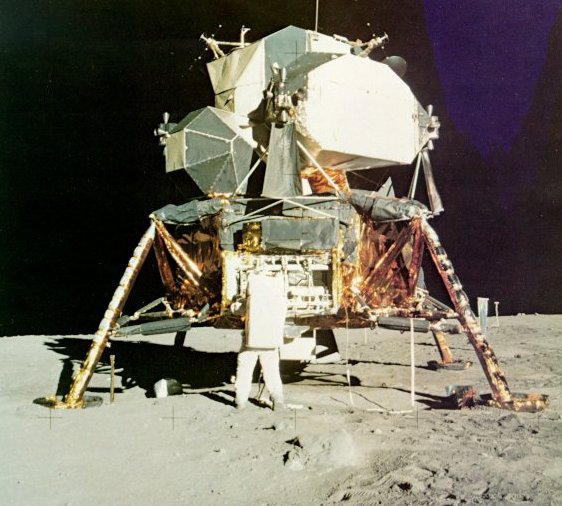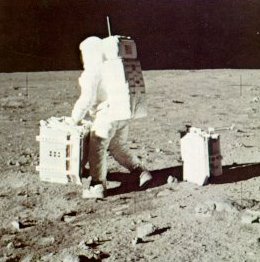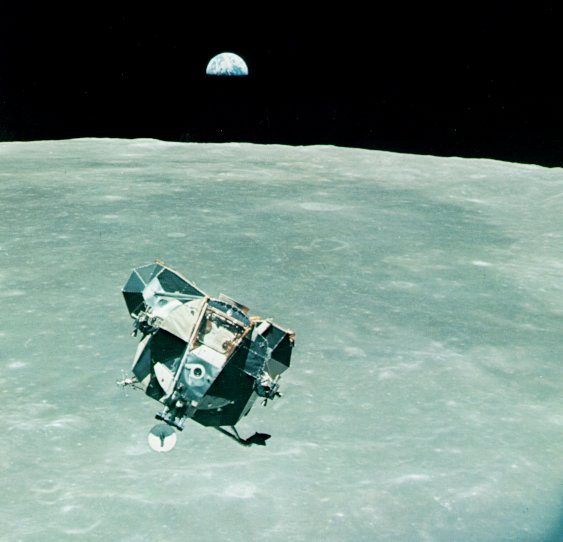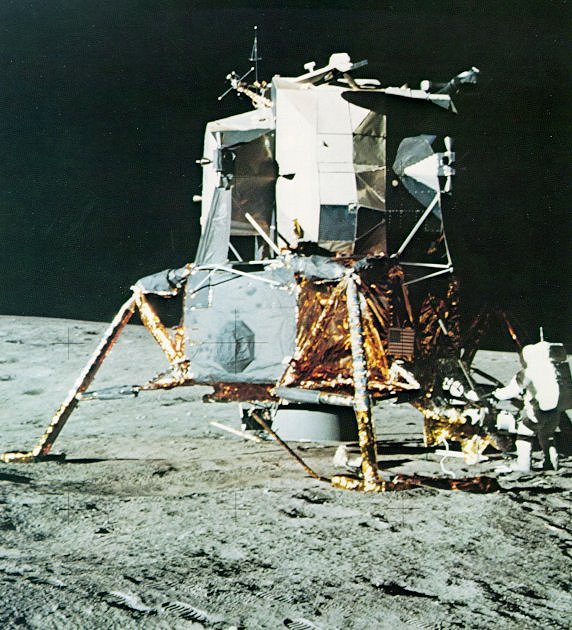Time Travel Research Center © 2005 Cetin BAL - GSM:+90 05366063183 - Turkey/Denizli
Apollo Expeditions to the Moon
CHAPTER 5
COAXING THE FLAG TO STAND
During a pause in experiments, Neil suggested we proceed with the flag.
It took both of us to set it up and it was nearly a disaster. Public
Relations obviously needs practice just as everything else does. A small
telescoping arm was attached to the flagpole to keep the flag extended and
perpendicular. As hard as we tried, the telescope wouldn't fully extend.
Thus the flags which should have been flat, had its own unique permanent
wave. Then to our dismay the staff of the pole wouldn't go far enough into
the lunar surface to support itself in an upright position. After much
struggling we finally coaxed it to remain upright, but in a most precarious
position. I dreaded the possibility of the American flag collapsing into the
lunar dust in front of the television camera.
COLLINS: [On his fourth orbital pass above] "How's it going?" "The EVA is
progressing beautifully. I believe they're setting up the flag now." Just
let things keep going that way, and no surprises, please. Neil and Buzz
sound good, with no huffing and puffing to indicate they are overexerting
themselves. But one surprise at least is in store. Houston comes on the air,
not the slightest bit ruffled, and announces that the President of the
United States would like to talk to Neil and Buzz. "That would be an honor,"
says Neil, with characteristic dignity.
The President's voice smoothly fills the air waves with the unaccustomed
cadence of the speechmaker, trained to convey inspiration, or at least
emotion, instead of our usual diet of numbers and reminders. "Neil and Buzz,
I am talking to you by telephone from the Oval Office at the White House,
and this certainly has to be the most historic telephone call ever made . .
. Because of what you have done, the heavens have become a part of man's
world. As you talk to us from the Sea of Tranquility, it inspires us to
redouble our efforts to bring peace and tranquility to Earth . . ." My God,
I never thought of all this bringing peace and tranquility to anyone. As far
as I am concerned, this voyage is fraught with hazards for the three of us-
and especially two of us- and that is about as far as I have gotten in my
thinking.
Neil, however, pauses long enough to give as well as he receives. "It's a
great honor and privilege for us to be here, representing not only the
United States but men of peace of all nations, and with interest and a
curiosity and a vision for the future."
 |
| Scientific experiments, stowed compactly for their trip to the Moon, are unpacked for deployment by Aldrin. Note the spread-leg stability of the landed LM, its sturdy legs foil-wrapped for thermal insulation. Beyond the right leg can be seen the solar-wind experiment, an exposed foil sheet that will be brought back to Earth for careful analysis; and beyond it the television camera. |
 |
Aldrin drops off the retroreflector for laser ranging of the Earth-Moon distance, and takes the seismometer experiment 15 feet farther out. The former gave new accuracy to measurement of the Moon's orbit. The seismometer was the first of an array of seismic stations now emplaced on the Moon. |
[Later] Houston cuts off the White House and returns to business as usual,
with a long string of numbers for me to copy for future use. My God, the
juxtaposition of the incongruous: roll, pitch, and yaw; prayers, peace, and
tranquility. What will it be like if we really carry this off and return to
Earth in one piece, with our boxes full of rocks and our heads full of new
perspectives for the planet? I have a little time to ponder this as I zing
off out of sight of the White House and the Earth.
ALDRIN: We had a pulley system to load on the boxes of rocks. We found the
process more time-consuming and dust-scattering than anticipated. After the
gear and both of us were inside, our first chore was to pressure the LM
cabin and begin stowing the rock boxes, film magazines, and anything else we
wouldn't need until we were connected once again with the Columbia. We
removed our boots and the big backpacks, opened the LM hatch, and threw
these items onto the lunar surface, along with a bagful of empty food
packages and the LM urine bags. The exact moment we tossed every thing out
was measured back on Earth- the seismometer we had put out was even more
sensitive than we had expected.
 |
| Ghosting up to its crucial rendezvous with Columbia, its legs and landing stage left behind on the surface as a launching platform, Eagle's historic voyage is almost done. Once its film, rock boxes, and two exhilarated astronauts have come aboard, Eagle will be left in lunar orbit while the three men set out for the distant half-planet shown here that is man's home. |
Before beginning liftoff procedures [we] settled down for our fitful rest.
We didn't sleep much at all. Among other things we were elated- and also
cold. Liftoff from the Moon, after a stay totaling twenty-one hours, was
exactly on schedule and fairly uneventful. The ascent stage of the LM
separated, sending out a shower of brilliant insulation particles which had
been ripped off from the thrust of the ascent engine. There was no lime to
sightsee. I was concentrating on the computers, and Neil was studying the
attitude indicator, but I looked up long enough to see the flag fall over .
. . Three hours and ten minutes later we were connected once again with the
Columbia.
COLLINS: I can look out through my docking reticle and see that they are
steady as a rock as they drive down the center line of that final approach
path. I give them some numbers. "I have 0.7 mile and I got you at 31 feet
per second." We really are going to carry this off' For the first time since
I was assigned to this incredible flight, I feel that it is going to happen.
Granted, we are a long way from home, but from here on it should be all
downhill. Within a few seconds Houston joins the conversation, with a
tentative little call. "Eagle and Columbia, Houston standing by." They want
to know what the hell is going on, but they don't want to interrupt us if we
are in a crucial spot in our final maneuvering. Good heads! However, they
needn't worry, and Neil lets them know it. "Roger, we're stationkeeping."
 |
||
| Astronaut Alan Bean unloads equipment from the Apollo 12 lunar module Intrepid in preparation for the walk to the ALSEP site. The lunar module-surely the clumsiest-looking flying machine ever built-consisted of a descent stage, destined to remain on the Moon, and an ascent stage that later carried the crew and sampies into lunar orbit. Scientific equipment and gear for use an the lunar surface was stowed in four bays of the descent stage. The panel that covered the bay facing Bean folded down to provide a work table. |